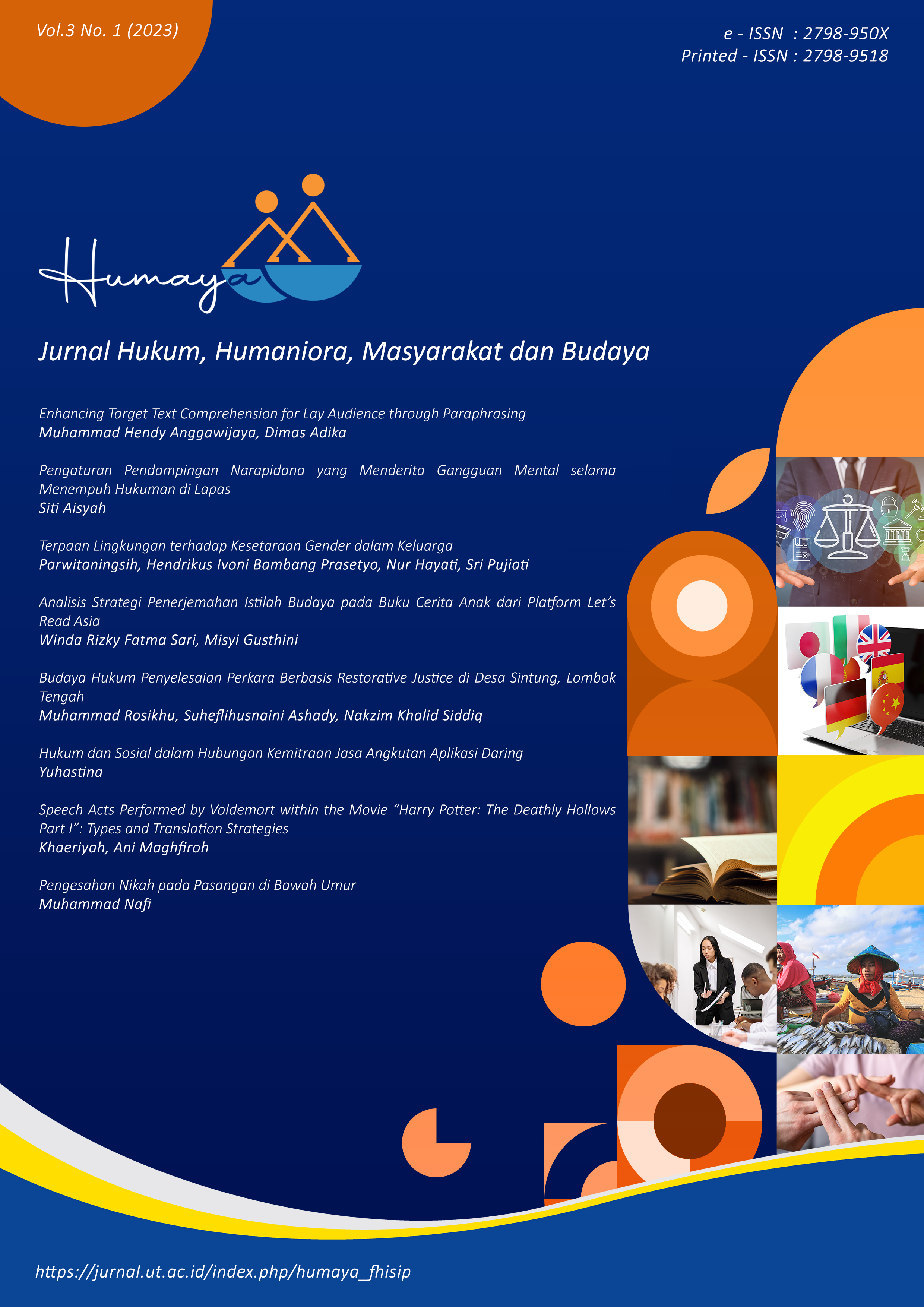Enhancing Target Text Comprehension for Lay Audience through Paraphrasing
DOI:
https://doi.org/10.33830/humaya.v3i1.4282Keywords:
English, paraphrasing, technique, text, translationAbstract
In translating English into Indonesian, paraphrasing technique is one of the procedures used to translate technical terms so they can be easily comprehended by the target audience. This article aims to highlight the use of paraphrasing in translating a scientific text titled “How Individuals Change Language” with lay audience as the main target. This paper used a qualitative method through analysis of the technique in translating the source text with two versions of translation being provided as steps, namely a default translation and a final one adjusted for the public. Each section provides a discussion of paraphrasing used to simplify the text’s technical terms. This article has received positive reviews from respondents proficient in English. This shows that paraphrasing technique is the best procedure used to translate texts with specific terms so they can be easily understood. This implies that translators of scientific texts with similar audiences may consider paraphrasing as one of the procedures to be used. This is because the procedure can be used to simplify and change various technical terms that are difficult to understand into their more intelligible counterparts.
References
Adika, D. (2017). Kajian Terjemahan Klausa Kompleks Proyeksi Pada Cerita-Cerita Rakyat Dwibahasa Di Indonesia. The 1st International Conference on Language, Literature and Teaching (ICOLLIT 1).
Budiman, R., Yusuf, S., Hidayat, R. S., & Darmojuwono, S. (2014). BING4318 – Teori dan Masalah Penerjemahan. Universitas Terbuka.
Cambridge Dictionary | English Dictionary, Translations & Thesaurus. (2022). https://dictionary.cambridge.org/
Darmayanti, P. D. (2020). Amplification and Transposition in English Commands and Its Translations into Indonesian with Reference to the Novel Entitled Harry Potter and The Order of Phoenix. RETORIKA: Jurnal Ilmu Bahasa, 6(1), 42–49. https://doi.org/10.22225/jr.6.1.1341.42-49
Departemen pendidikan nasional. (2008). Kamus besar bahasa Indonesia. Gramedia pustaka utama .
Harmon, L. (2013). Paraphrasing as a translation strategy. https://www.researchgate.net/publication/294087258_Paraphrasing_as_a_translation_strategy
Hidayat, A., & Harmoko, D. D. (2018). Parafrasa dalam terjemahan novel peebee has a wish. Retorika. RETORIKA: Jurnal Bahasa, Sastra, Dan Pengajarannya, 11(1), 1–13. https://doi.org/10.26858/RETORIKA.V11I1.4962
Kendenan, E. S. (2018). Analisis Penerapan Teknik Amplifikasi dalam Terjemahan “Gadis Pantai” Karya Pramoedya Ananta Toer ke dalam Bahasa Inggris.
Komang, I., Putra, S., & Putri, D. R. (2017). Comparative Analysis Of Translation Between The Source Language (Sl) And The Target Language (Tl) In Tagore’s Poetry: Gitanjali, Songs Of Offerings. Lingual, 9(2).
Larson, M. L. (1998). Meaning-based Translation: A Guide to Cross-language Equivalence. University Press of America.
Mahmud, E. Z., Bayusena, B., & Ampera, T. (2021). Amplification Technique Of Translation In The Target Language Novel “Earth Dance". 4. http://www.balix.com/travel/guide/chapter
Måns Westling. (2011). A Comparative Translation Study of Strindberg’s The Red Room (1879).
Molina, L., & Albir, A. (2002). Translation Techniques Revisited: A Dynamic and Functionalist Approach. In Meta: Journal des traducteurs (Vol. 47). https://doi.org/10.7202/008033ar
Newmark, P. (1988). A Textbook of Translation. Prentice-Hall International. https://books.google.co.id/books?id=ABpmAAAAMAAJ
Nida, E. A., & Taber, C. R. (2003). The Theory and Practice of Translation. Brill. https://books.google.co.id/books?id=JtSeXat1wxQC
Sentana, A. (2020). An Analysis Of Explicitation In The Novel Pembunuhan Di Malam Natal. Journal of Language and Literature, 8(1), 1–14. https://doi.org/10.35760/jll.2020.v8i1.2622
Vinay, J.-P., & Darbelnet, J. (1984). Comparative Stylistcs of French and English. In Journal of Chemical Information and Modeling (Issue 9).
Downloads
Published
How to Cite
Issue
Section
License
Copyright (c) 2023 Muhammad Hendy Anggawijaya, Dimas Adika

This work is licensed under a Creative Commons Attribution-ShareAlike 4.0 International License.




